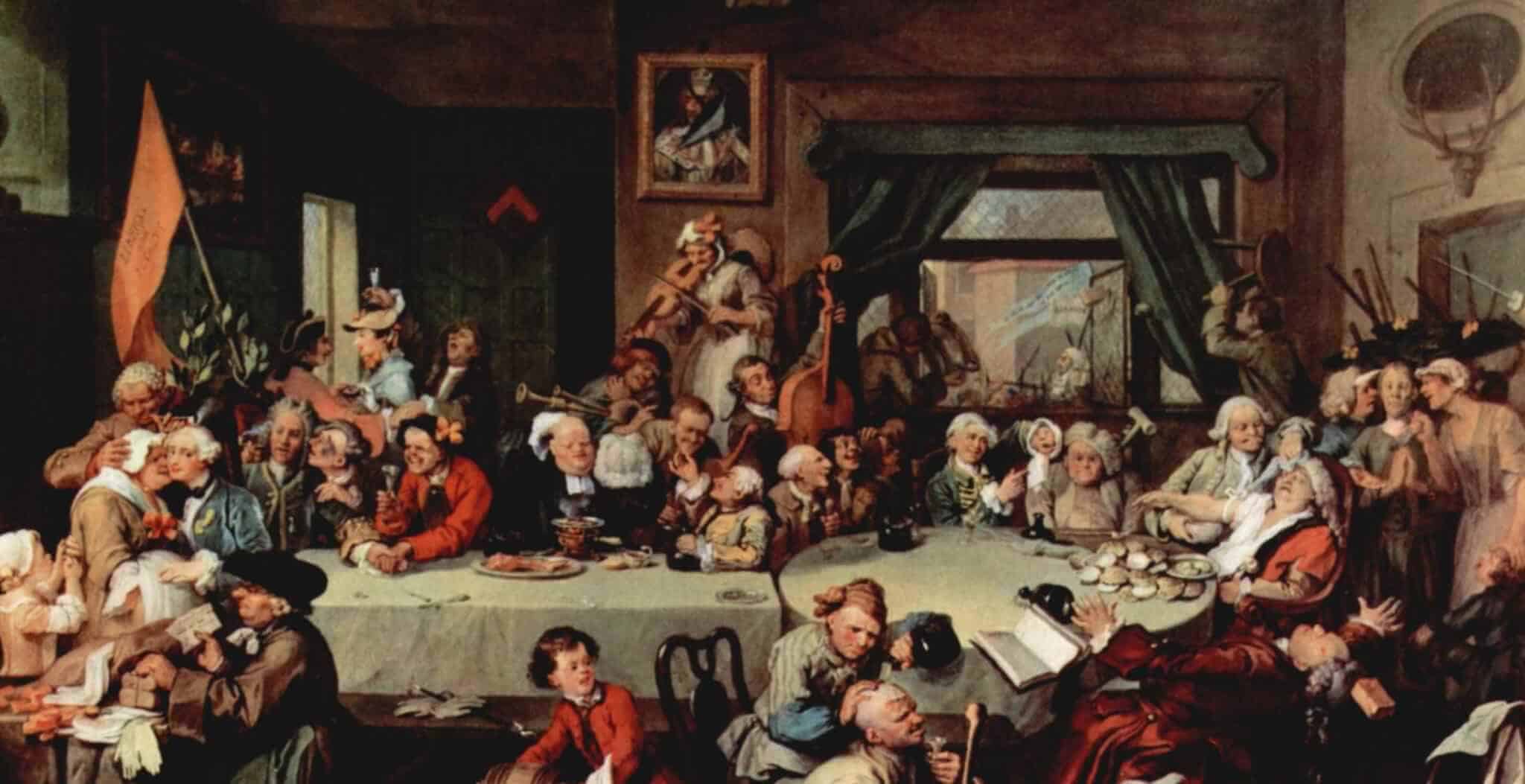Welcome to part three of our Fashion Through the Ages series. Starting from medieval fashion ending at the swinging sixties, this section covers British fashion during the Georgian period.
 |
Man’s Day Clothes about 1738
This gentleman wears a smart summer suit, with the coat more tightly fitting than at the end of the 17th century. It is made of plain cloth embroidered on edges and pockets, which are raised to hip level. The waistcoat is plain and the breeches are tighter and fasten below the knee. The shirt is frilled at the cuff and around the neck is a knotted muslin or lace cravat. He wears his own hair. For formal occasions a powdered wig tied back with a bow would be worn and his coat and waistcoat would be of patterned silks. |
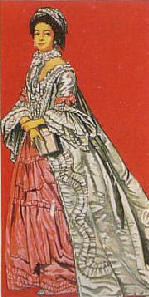 |
Lady’s Day Dress about 1750
This lady (left) wears a ‘sackback’ dress developed from the flowing undress gowns of 17th century. Beneath are a stiff corset and cane side hoops supporting the skirts. The frills of her shift show at the neck, veiled in a muslin ‘kerchief’ and at the opening of her wing-like cuffs, which are typical of the 1750’s. She wears a round muslin cap, the central pleat recalling the ‘fontange’ (1690 – 1710). For formal dress she would wear richly brocaded or embroidered silks. |
 |
Man’s Day Clothes about 1770
This gentleman wears a plain coat, tightly fitting and cut away, forming curving tails. The waistcoat is shortened to just below the waist and the breeches are longer and tighter than before. His coat has a band collar and he wears a rather stiff stock instead of a cravat. He wears his own hair, but for formal occasions he would have a powdered wig, dressed high and tied at the back. Embroidery and trimming were no longer fashionable except for formal wear. |
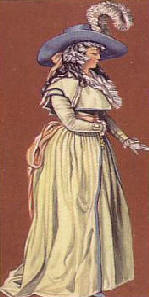 |
Lady’s Day Dress about 1780
This dress is typical of the simple countrified styles which became fashionable towards the end of the century. It is a ‘redingote’ or riding coat, modelled on a man’s coat. The waist has become shorter and the bosom is padded by a muslin ‘buffon’ neckerchief and the hips by a ‘false rump’. The hair is dressed in a mass of loose curls and the lady wears a huge hat inspired by a mid-17th century riding hat. Woollen cloth, cotton and linen had become fashionable materials, while silks were worn for evening, as were small hoops since wide ones were only worn for court. |
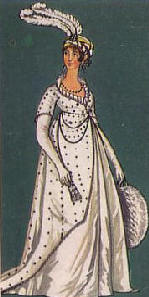 |
Lady’s Formal Dress 1802
There was great interest at this time in ancient Greece and Rome, and this lady wears ‘fashionable full dress’, the style based on the drapery of classical statues. The waist is high and uncorsetted, and the materials light in colour and texture. Muslin had become a fashionable fabric. Her gown is still 18th century in cut, but for day wear it would have bodice, skirt and petticoat in one piece. Her accessories are varied: she carries a huge swansdown muff, wears long white gloves, has a tasselled girdle and a feather-trimmed turban. |
In 1795, in order to raise revenue, a tax was imposed on hair powder by William Pitt. However this tax failed as people promptly abandoned the wearing of powdered wigs and the tax raised just 46,000 guineas.
 |
Man’s Day Clothes 1805
Informal day dress is shown here, the illustration taken from a sketch portrait of George (Beau) Brummell, the fashionable ideal (and famous dandy) of his age. He persuaded men to think that dark, well cut and fitted clothes were smarter than colourful ostentatious ones. He usually wore a cut-away cloth coat with brass buttons, plain waistcoat matching his pantaloons (which replaced shorter breeches in about 1805), hessian riding boots and a hard conical riding hat, introduced in the late 18th century. Great care was taken in the laundering and tying of his stiffly starched cravat. For evening he wore a black coat and silk pantaloons instead of old fashioned knee breeches. |
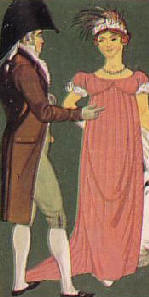 |
Evening Clothes about 1806
The lady wears a one-piece dress introduced at the end of the 18th century. Its design was inspired by the new interest in classical works of art. It has a high waist, straight skirt unsupported by petticoats and very short sleeves. Contemporaries found it daring and immodest! The material is light and striped. For warmth she has a shawl, wears long gloves and carries a muff. The gentleman’s cut-away tail coat of fine cloth with velvet collar, silk stockings, tie wig and bicorne hat recall day clothes of the 18th century and anticipate the evening styles of the 20th century. Formal dress is usually a day style which persists, remaining unchanged though long since out of fashion. |
The period after 1811 is known as the Regency period, as the Prince of Wales (later King George IV) ruled as Regent from that time until the death of his father George III in 1820.
 The fashions of this era are quite familiar to us, as these are the styles of dress portrayed in the popular TV adaptations and films of Jane Austen novels, such as the 1995 Andrew Davies adaptation of ‘Pride and Prejudice’ for the BBC. ITV’s Sharpe is based in this era too, during the Peninsular and Napoleonic Wars.
The fashions of this era are quite familiar to us, as these are the styles of dress portrayed in the popular TV adaptations and films of Jane Austen novels, such as the 1995 Andrew Davies adaptation of ‘Pride and Prejudice’ for the BBC. ITV’s Sharpe is based in this era too, during the Peninsular and Napoleonic Wars.
The Napoleonic Wars were a series of conflicts fought between France under the leadership of Napoleon Bonaparte and a number of European nations, including Great Britain, between 1799 and 1815.

 |
Day Clothes about 1825
The lady’s dress assumes a new outline. The waist has dropped to natural level and the sleeves and skirt are wide and full. The colours are bright, trimmings elaborate and much jewellery is worn. Accessories are varied, the most noticeable being the vast hat trimmed with many ribbon bows. The man wears elegant walking dress also with a slight fullness at the shoulder and a waistcoat with lapels. He wears tight pantaloons acceptable for day wear after about 1805 and wears a higher ‘top’ hat. |
 |
Welsh Country Dress about 1830
This Welsh girl from a painting of about 1830, shows how fashion lags behind in remote places. She wears a gown of 18th century cut, over a stiff corset, a printed neckerchief and a petticoat protected by a check apron. Her dress is probably made from Welsh woollen material, her mittens and stockings being knitted. Her high crowned hat can be traced back to 17th century fashions. Many wore a red, caped cloak no different from that worn by English countrywomen in the 18th and 19th century. This and the hat are the two essentials of Welsh national dress as we know it today. |
Related Links:Part 1 – Medieval Fashion |





